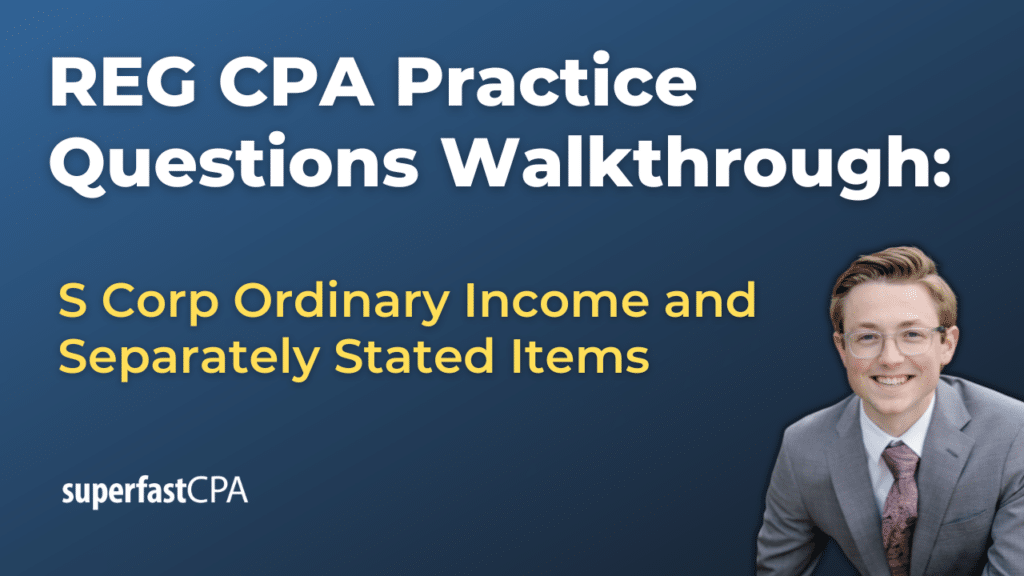In this video, we walk through 5 REG practice questions teaching how to calculate S Corporation ordinary income and separately stated items. These questions are from REG content area 5 on the AICPA CPA exam blueprints: Federal Taxation of Entities.
The best way to use this video is to pause each time we get to a new question in the video, and then make your own attempt at the question before watching us go through it.
Also be sure to watch one of our free webinars on the 6 “key ingredients” to an extremely effective & efficient CPA study process here…
Overview of How to Calculate S Corporation Ordinary Income and Separately Stated Items
An S corporation is a special type of corporation that elects to pass corporate income, losses, deductions, and credits through to their shareholders for federal tax purposes. Shareholders of S corporations report the pass-through of income and losses on their personal tax returns and are assessed tax at their individual income tax rates. This allows S corporations to avoid double taxation on the corporate income.
Ordinary Income
Ordinary income for an S corporation is the income derived from its regular business operations after all operating expenses have been deducted. This is essentially the corporation’s net income from its operations and is taxed to the shareholders at their respective individual tax rates.
Components of Ordinary Income:
- Gross Income: Includes all income from sales, services, or other business activities.
- Less: Cost of Goods Sold (COGS): Direct costs attributable to the production of the goods sold by the company.
- Less: Operating Expenses: These include salaries, rent, utilities, and other expenses directly related to the business operations.
Calculation Example:
- Gross Sales: $500,000
- COGS: $200,000
- Operating Expenses (salaries, rent, etc.): $150,000
- Ordinary Income = $500,000 – $200,000 – $150,000 = $150,000
Separately Stated Items
Separately stated items are those items of income, loss, deduction, or credit that must be reported separately from the ordinary income on the S corporation’s tax return because they can affect the tax liability of shareholders differently. These items retain their character as they pass through to the shareholders and can include various types of income and deductions.
Common Separately Stated Items:
- Dividend Income
- Interest Income
- Rental Income
- Capital Gains and Losses
- Section 179 Deduction
- Charitable Contributions
- Royalties
Special Notes:
- Section 179 Deduction: This deduction allows businesses to deduct the full purchase price of qualifying equipment purchased or financed during the tax year. For S corporations, this deduction is a separately stated item because it is subject to various limitations at the shareholder level.
- Salaries to Shareholder-Employees: These are not guaranteed payments (which are only applicable in partnerships) but are ordinary business expenses. However, salaries to shareholders must be reasonable and are scrutinized by the IRS.
Example:
Financial Data for the Year:
- Sales Revenue: $400,000
- Cost of Goods Sold: $160,000
- Operating Expenses (including salaries, rent, etc.): $100,000
- Dividend Income (from investments): $5,000
- Interest Income (from corporate bonds): $2,000
- Capital Gain (from sale of an asset): $10,000
- Charitable Contributions: $3,000
Separately Stated Items: Each of these items has specific tax implications for the shareholders and must be reported separately on the K-1 forms:
- Dividend Income: Affects tax rates and possible qualified dividend treatment.
- Interest Income: May affect investment income calculations.
- Capital Gain: Subject to capital gains tax rates, different from ordinary income tax rates.
- Charitable Contributions: Deductible on the shareholder’s personal tax returns, subject to their individual limits.
Reporting
- Ordinary Income of $140,000 is reported as part of the S corporation’s income on shareholders’ tax returns.
- Separately Stated Items are listed individually on Schedule K-1 to ensure each shareholder handles these items according to their own tax situation.
Conclusion
When preparing S corporation tax returns, it’s crucial to correctly categorize and calculate ordinary income and separately stated items. Ordinary income is generally subject to regular income tax, while separately stated items may be subject to different tax treatments depending on the shareholders’ individual tax situations.













